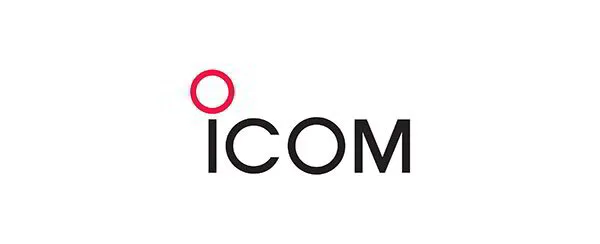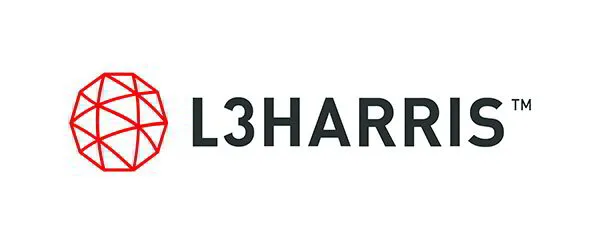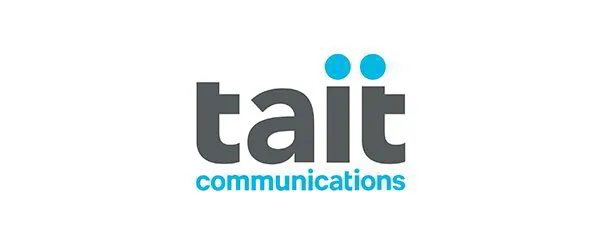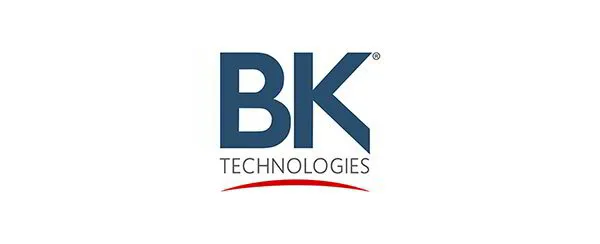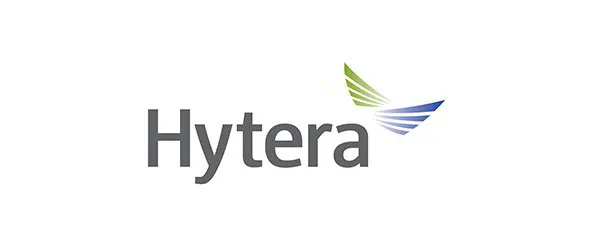
One of the Most Complete Communication Networks in the Northwest
White Cloud Communications Inc., an Idaho-based company with nearly 50 years of expertise, is headquartered in Twin Falls and operates satellite offices in Garden City, Burley, and Idaho Falls. We specialize in advanced two-way radio services, designing, developing, and delivering innovative solutions that boost productivity, enhance safety, and connect people in the toughest environments. Our mission is to provide seamless, reliable, and instant communication for businesses and communities across southern Idaho. With a focus on innovation, quality, and a customer-first mindset, we aim to be the trusted leader in wireless communication solutions.
Industries
Table of Contents
Understanding Emergency Responder Radio Coverage Systems
In high-rise buildings or sprawling industrial complexes, poor radio coverage can turn a routine emergency into a crisis, delaying first responders and endangering lives. Emergency Responder Radio Coverage Systems (ERRCS) serve as the building’s radio lifeline, ensuring reliable in-building communications for firefighters, police, and EMS personnel. Post-9/11 code evolutions highlighted these risks, leading to strict mandates for in-building signal compliance. Professional emergency radio system compliance testing verifies that systems meet these standards, mitigating dead zones and supporting swift rescues.
ERRCS typically incorporate bi-directional amplifiers (BDA) and distributed antenna systems (DAS) to boost public safety radio signals. Under International Fire Code (IFC) Section 510, buildings must achieve 95% coverage with a signal strength of at least -95 dBm, as outlined in Section 510.1 for general requirements. Common applications span hospitals for patient evacuations, schools for active shooter responses, and industrial sites for hazardous material incidents. BDA system commissioning involves initial acceptance tests to confirm performance, followed by periodic verifications aligned with ERRCS testing requirements, including annual checks per NFPA 72 and certification under UL 2524. Certified technicians are essential to handle these complex installations, preventing fines and enhancing public safety.
This guide progresses from ERRCS fundamentals to advanced compliance strategies, covering testing phases like signal verification and maintenance. White Cloud Communications, with over 50 years of expertise and a robust southern Idaho tower network, offers tailored ercs testing services for seamless certification. To achieve this compliance, start with understanding the core standards and components detailed next.
Fundamentals of ERRCS Standards
Having established the importance of ERRCS, let’s examine the core standards that govern their design and operation. Emergency Responder Radio Coverage Systems (ERRCS) ensure reliable in-building communication for first responders, evolving from basic fire codes to comprehensive public safety mandates. In southern Idaho, where buildings like hospitals and mining facilities face unique challenges, compliance with these standards is critical. White Cloud Communications guides operators through initial setups, leveraging local expertise to meet regional fire code variations.
The history of ERRCS standards traces back to the early 2000s, driven by incidents where weak signals hindered emergency responses. The International Fire Code (IFC) and National Fire Protection Association (NFPA) developed guidelines to address dead zones in large structures. Today, these codes interconnect to form a unified framework: IFC provides structural requirements, NFPA focuses on functionality, and UL standards ensure equipment reliability. This synergy is vital for buildings over 50,000 square feet in Idaho, where seismic and rural signal considerations apply.
Key components form the backbone of any ERRCS. Donor antennas capture external signals from public safety radios. Bi-Directional Amplifiers (BDAs) boost these signals for in-building use, while Distributed Antenna Systems (DAS) distribute coverage evenly. Basic radio coverage standards ensure no dead zones exceed 5% of the area. These elements integrate with fire alarm systems for unified monitoring, supporting emergency signal fundamentals like voice clarity and data transmission.
- Donor antennas: Positioned on rooftops to receive strong outdoor signals.
- BDAs: Amplify inbound and outbound frequencies without distortion.
- DAS: Network of indoor antennas for uniform propagation.
- Monitoring panels: Track system health per NFPA 72.
- Coverage mapping tools: Identify weak spots during commissioning.
In Idaho, adaptations for mining facilities often include ruggedized components to handle dust and vibration, emphasizing White Cloud’s tailored designs.
The core standards detail specific compliance needs. IFC Section 510 mandates 95% in-building coverage for new and existing buildings over 50,000 square feet, stating, “Emergency responder radio coverage shall be provided in all new buildings and structures.” NFPA 72 outlines monitoring and control functions, requiring visual and audible supervision of ERRCS components. UL 2524 verifies BDA performance, ensuring listed equipment meets gain and noise criteria. These interconnect because IFC references NFPA for design, while UL supports both through testing protocols. Regional Idaho fire codes, aligned with IFC, incorporate local amendments for high-risk areas like Twin Falls warehouses.
The following table compares core requirements across these standards for easy reference:
| Standard | Coverage Requirement | Signal Strength Threshold | Testing Frequency |
|---|---|---|---|
| IFC 510 | Requires 95% in-building coverage for public safety frequencies. | -95 dBm minimum for voice and data. | Annual and upon modifications |
| NFPA 72 | Mandates system design for reliable emergency communications. | Similar thresholds with added donor signal considerations. | Annual supervision tests; five-year full certification |
| UL 2524 | Focuses on BDA equipment listing and performance verification. | Verifies amplifier gain and noise figures. | Compliance verified pre-installation and periodically |
Data sourced from IFC official code; NFPA guidelines; UL standards documentation. For Idaho buildings, this means prioritizing IFC’s coverage with NFPA’s reliability checks, potentially adding UL-listed gear for mining or hospital projects to avoid fines up to $1,000 per violation.
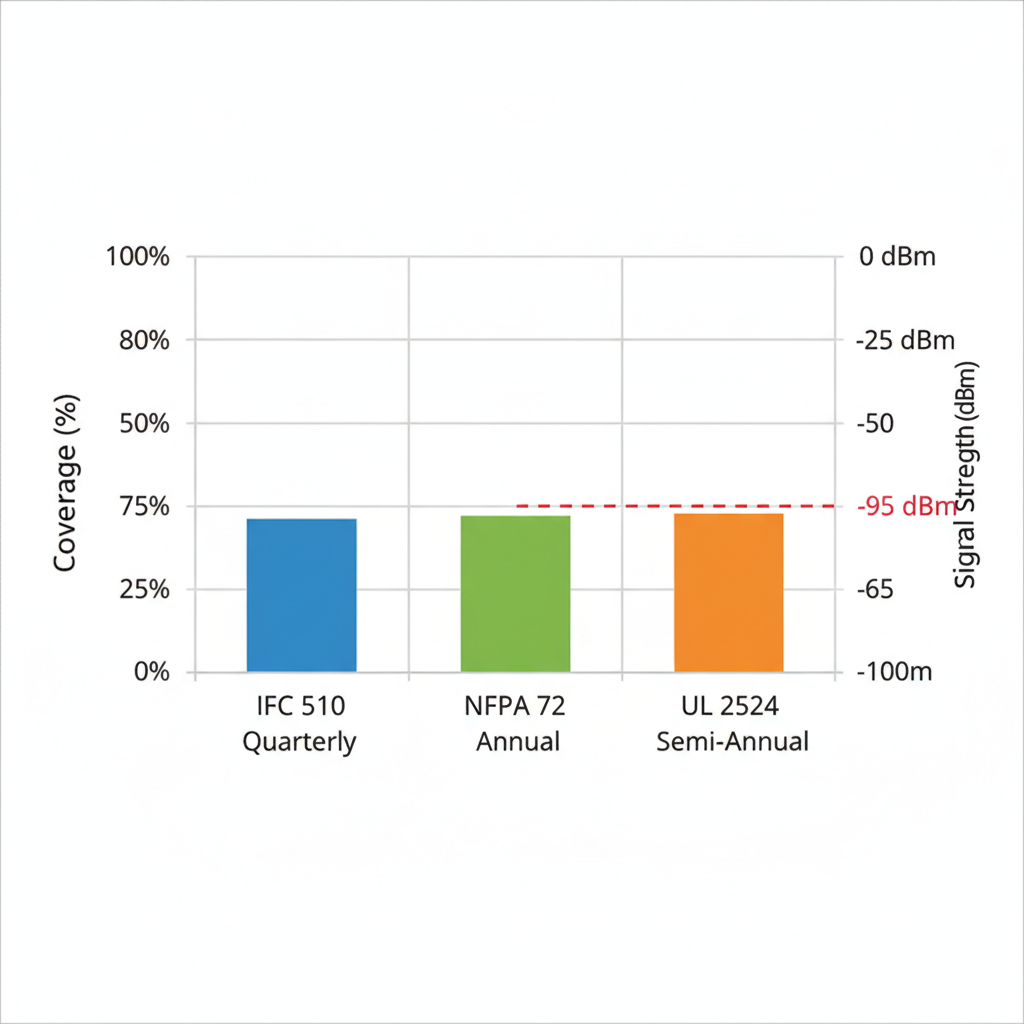
Visual comparison of essential ERRCS standards for compliance
Acceptance testing protocols introduce verification steps. The erces testing process outlines donor signal checks and in-building simulations. For NFPA 72, ERRCS testing requirements include annual performance tests covering gain measurements and coverage mapping, including an emergency response enhancement system test to validate gain and signal uniformity. What is included in an annual ERRCS performance test? It features Test Emergency Radio System Compliance via grid simulations, ensuring -95 dBm thresholds, plus donor tests every five years. Documentation like as-built drawings records these, linking to detailed procedures explored next. White Cloud handles these for seamless compliance in southern Idaho.
In-Depth ERRCS Testing Procedures
Building on core standards, the testing procedures ensure they are met through rigorous methodologies tailored for commercial structures in Idaho. White Cloud Communications employs certified technicians to conduct these tests, verifying signal coverage and compliance with IFC 510 requirements. This approach guarantees reliable emergency communications, preventing delays in critical responses.
Acceptance Testing for New Installations
Acceptance testing occurs immediately after ERRCS installation and before issuing the certificate of occupancy, aligning with Test Emergency Radio System Compliance Idaho Falls protocols. The process begins with a comprehensive site survey to identify potential interference sources, followed by equipment calibration using NIST-traceable standards. Technicians then perform a full-building walkthrough, mapping signal strength at multiple points to confirm at least 95% coverage above -95 dBm for public safety bands.
Key steps include:
- Pre-test preparation: Verify BDA system commissioning by checking donor antenna alignment and amplifier functionality.
- Signal mapping: Use walk-testing to collect data across floors, ensuring no dead zones in critical areas like stairwells and basements.
- Integration with inspections: Coordinate with fire marshals for ercs code inspection, submitting test reports and coverage diagrams for sign-off.
This phase addresses common pitfalls like multi-band support for P25 and LTE, with White Cloud’s 24/7 support available to troubleshoot amplifier overloads. Documentation, including as-built drawings and compliance checklists, is essential for IFC approval, typically completed within 48 hours post-installation. Without certified oversight, DIY attempts risk non-compliance and safety hazards.
Periodic Re-Verification Methods
Periodic re-verification maintains ERRCS efficacy against degradation from environmental factors or equipment wear, adhering to NFPA 1225 standards. Annual tests focus on donor site evaluations and basic signal checks at fixed points, ensuring ongoing adherence to ERRCS testing requirements. These involve visual inspections of bi-directional amplifiers (BDAs) and noise figure measurements to detect early failures.
For five-year full-system verifications, protocols escalate to comprehensive recalibration using certified spectrum analyzers, including full walk-tests and coverage remapping. White Cloud’s process in Test Emergency Radio System Compliance Idaho Falls exemplifies regional adaptations, where tower-linked networks account for Idaho’s terrain variations, achieving up to 20% signal improvement per Powerful Signal case studies.
Breakdown by frequency:
- Annual: Quick donor checks and 10% random sampling; costs around $1,500, lasting one day.
- Five-Year: Complete system scan with recalibration; $5,000+, spanning two days, including report generation.
Troubleshooting covers interference from new construction, with recalibration restoring compliance. Detailed radio testing protocols emphasize certified equipment to avoid false readings, integrating with fire marshal reviews for documentation like trend analysis reports. White Cloud warns against uncertified DIY re-verifications, recommending professional service to uphold public safety in hospitals and campuses.
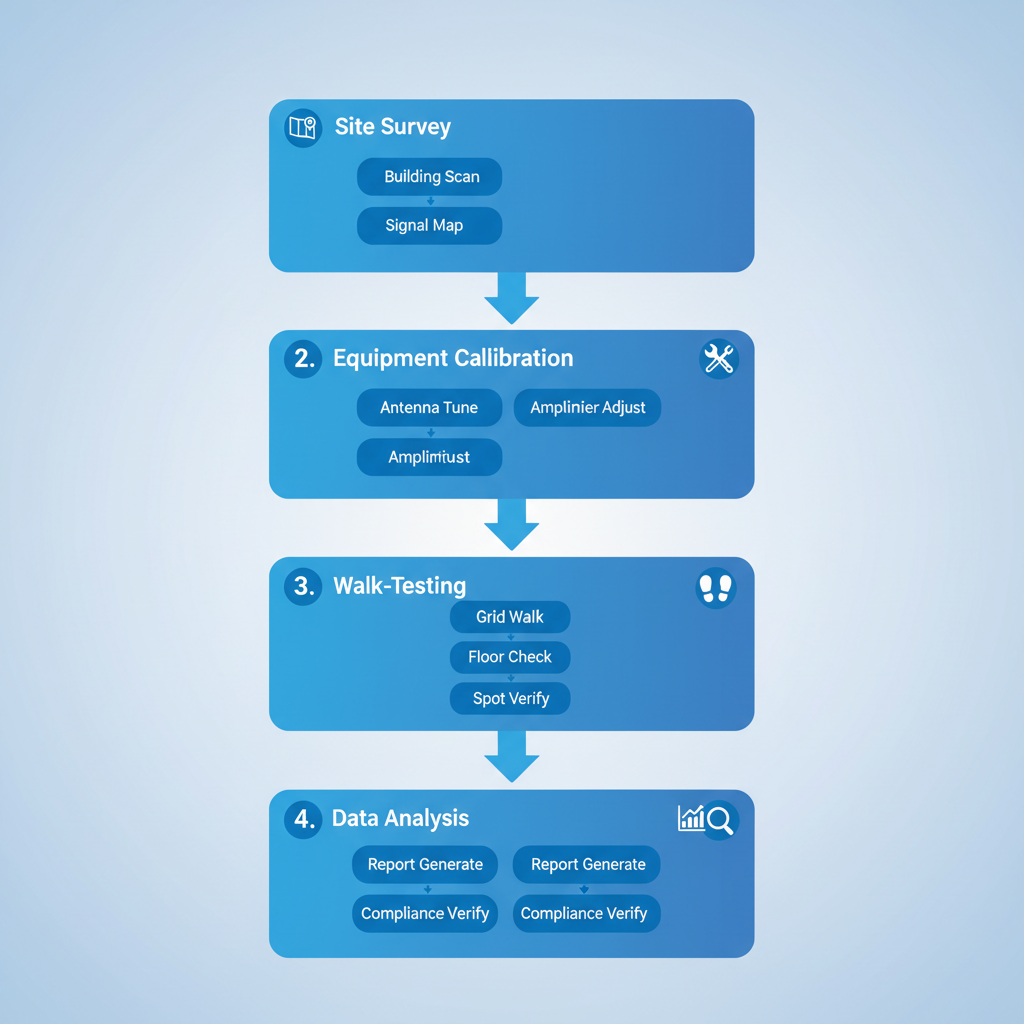
Vertical process flow diagram of in-depth ERRCS testing procedures
Signal Strength Measurement Techniques
Signal strength measurement techniques rely on precise tools to quantify dBm levels, ensuring compliance verification steps meet -95 dBm thresholds for first responders. Walk-testing involves handheld devices scanning public safety frequencies during movement, while fixed-point sampling at 20-30 locations per floor provides baseline data. Donor site evaluations assess external signal quality, critical for BDA performance in urban Idaho settings.
Tools like spectrum analyzers offer detailed frequency analysis per Anritsu guidelines, identifying harmonics in P25 and LTE bands. Compliance verification steps include noise floor checks to prevent overload, with data logged for trend monitoring. White Cloud integrates these with software for automated reporting, addressing queries on BDA system commissioning durations–typically 4-6 hours for initial scans.
Selecting the right tools is crucial based on accuracy needs and budget, as outlined in NFPA 1225 for IFC 510 adherence.
| Tool | Use Case | Accuracy Level | Cost Range |
|---|---|---|---|
| Spectrum Analyzer | Precise frequency measurements | ±0.5 dB | High ($5K+) |
| Signal Booster Tester | BDA gain and noise verification | ±1 dB | Medium ($1-3K) |
| Coverage Mapping Software | Automated walkthrough data | ±2 dB with GPS | Low ($500+) |
These tools enhance precision in Idaho buildings, where varied structures demand robust verification; for instance, spectrum analyzers excel in multi-story compliance checks, reducing re-test needs by 30%.
For broader protocol comparison:
| Test Type | Frequency | Scope | Cost Estimate |
|---|---|---|---|
| Annual | Yearly | Donor checks, basic sampling | $1,500 |
| Five-Year | Every 5 years | Full recalibration, remapping | $5,000+ |
Annual tests efficiently spot degradation, while five-year evaluations ensure long-term IFC compliance, supporting White Cloud’s maintenance contracts.
These methods form the basis for hands-on implementation covered next.
Practical Steps for IFC 510 Compliance
With testing methods understood, now implement them through these practical compliance steps. Achieving IFC 510 compliance requires meticulous planning and execution, especially for Idaho’s commercial buildings where White Cloud Communications provides expert support. The following table offers a quick reference for key actions and pitfalls to ensure smooth ERRCS testing.
| Step | Required Action | Common Pitfall |
|---|---|---|
| Site Survey | Conduct pre-install assessment. | Ignoring building materials’ impact. |
| Signal Testing | Verify 95% coverage. | Inadequate walk-test paths. |
| Documentation | Submit as-builts and reports. | Missing coverage maps. |
This checklist, derived from IFC 510 and NFPA guidelines, streamlines Test Emergency Radio System Compliance by highlighting essentials versus frequent errors, saving time and avoiding costly rework.
In Idaho contexts, such as Twin Falls warehouses, overlooking pitfalls like material interference can delay approvals; proactive checks enable rapid BDA system commissioning with local experts like White Cloud for reliable public safety signals.
Preparing for ERRCS Coverage Tests
Schedule ERRCS testing requirements with the Authority Having Jurisdiction (AHJ) at least 30 days in advance to align with local fire codes in southern Idaho. Notify building occupants and coordinate with certified engineers holding FCC and manufacturer certifications, who are qualified to conduct ERRCS testing and certification. White Cloud’s team, with over 50 years of experience, handles these notifications efficiently for commercial sites like hospitals or manufacturing facilities.
Prepare the site by clearing access paths and securing sensitive areas to facilitate safe on-site radio testing. Develop a detailed checklist for BDA system commissioning, including signal engineering tools and safety protocols such as grounding equipment to prevent electrical hazards. Emphasize bda system solutions during this phase, as White Cloud’s integrated designs remove dead zones and support in-building public safety.
Gather calibrated equipment: spectrum analyzers, test transmitters, and logging software verified against IFC 510 Section 510.5 standards. Conduct a preliminary walkthrough to map grid patterns for multi-floor coverage, estimating 1-3 days total for commissioning based on building size–smaller retail spaces may take one day, while larger campuses extend to three. Use this preparation to address relevant questions, like what checklist is used for BDA system commissioning, by incorporating templates for inventory and timelines. White Cloud’s rapid response ensures all tools are ready, fostering confidence for non-experts navigating these practical compliance steps.
Conducting On-Site Verifications
Begin on-site verifications with a systematic walkthrough using predefined grid patterns, starting from the ground floor and progressing upward to capture multi-level signal propagation. Activate the BDA and monitor signals in real-time, logging data every 10 feet along paths frequented by emergency responders, per ERRCS testing requirements. Qualified technicians, certified in P25 and LMR standards, perform these tests to verify 95% coverage thresholds as mandated by IFC 510.
Implement data logging protocols with handheld scanners and apps to record RSSI values, ensuring accuracy in bda das verification. Adjust donor antennas or fiber links on-the-fly if signals dip below -95 dBm, incorporating safety measures like lockout-tagout for electrical panels. For example, in a Boise office tower, real-time tweaks during walk-testing prevented remediation by optimizing DAS distribution.
Differentiate annual testing–focused on quick signal checks–from five-year full verifications, which include comprehensive grid analysis and equipment calibration. White Cloud’s skilled installers execute these protocols, addressing how long it takes to commission a BDA system by adapting to site complexities. Use imperative actions: Traverse all corridors; test elevator shafts; document anomalies immediately. This hands-on approach, informed by Powerful Signal examples, ensures robust emergency connectivity while maintaining an encouraging pace for teams.
Post-Test Documentation and Approval
Compile test logs into a comprehensive report, including coverage maps generated from logged data to visualize 95% compliance zones. Detail any remediation steps taken, such as amplifier recalibration, and include signal threshold metrics from IFC 510 Section 510.5. White Cloud streamlines this with digital templates, expediting submissions for Idaho fire permits.
Create as-built diagrams showing BDA placements and cable routes, essential for AHJ review. Submit the package–reports, maps, and certifications–within 14 days, signed by certified engineers. Address who is qualified by noting requirements like UL2524 compliance and NFPA 72 adherence, which White Cloud technicians meet.
These basics prepare for sophisticated challenges in larger systems discussed next, with White Cloud’s end-to-end support ensuring seamless IFC 510 adherence for your operations.
Advanced ERRCS Maintenance Strategies
Beyond initial compliance, advanced strategies ensure endurance for Emergency Responder Radio Coverage Systems (ERRCS) in Idaho buildings. These approaches focus on predictive monitoring, timely upgrades, and robust service contracts to adapt to evolving codes like IFC Section 510. White Cloud Communications partners with facility managers to implement forward-thinking solutions that enhance public safety and minimize downtime.
Advanced system upkeep begins with remote monitoring systems integrated via SCADA for real-time oversight. This technology allows continuous assessment of signal strength and battery health, addressing multi-tenant challenges where shared infrastructure demands precise coordination. Predictive analytics, powered by tools from Anritsu, forecast potential failures by analyzing usage patterns and environmental factors. According to NFPA 1225 guidelines, such strategies can reduce system outages by up to 35%, ensuring sustained radio compliance through automated alerts and data logging. For ongoing records needed for ERRCS testing requirements and IFC Section 510 compliance, these systems generate comprehensive documentation, including signal logs and performance reports. Phased implementation starts with baseline audits, followed by sensor installations, helping buildings maintain coverage without disruptive interventions.
The following table compares annual versus five-year maintenance cycles, highlighting the escalation from routine checks to comprehensive overhauls based on NFPA 72 and IFC guidelines for periodic testing.
| Aspect | Annual Maintenance | Five-Year Maintenance |
|---|---|---|
| Scope | Basic signal checks and logs. | Full system disassembly and recalibration. |
| Coverage | Donor site verification, minor adjustments. | Component replacement, full coverage remap. |
Annual routines provide essential benchmarks but often miss emerging issues, while five-year plans offer deeper insights into system integrity. Adopting advanced cycles yields long-term ROI, with proactive measures cutting emergency repair costs by 25% and extending equipment life.
Upgrade paths ensure ERRCS evolves with technological advances, particularly for narrowband compliance. When integrating new frequencies or 5G enhancements, conduct thorough verifications aligned with Test Emergency Radio System Compliance protocols to meet updated IFC 510 amendments. For multi-tenant properties, upgrades involve coordinated donor site optimizations and full coverage remapping to eliminate dead zones. White Cloud’s engineers guide phased upgrades, starting with assessments and progressing to component swaps, often reducing signal loss by 20% in case studies from Idaho commercial sites. Proactive upgrades not only satisfy evolving codes but also boost operational efficiency, with ROI realized through fewer compliance fines and improved responder reliability. Documentation from these processes supports annual audits, answering key questions on testing requirements and sustained performance.
Service contracts form the backbone of proactive ERRCS management, offering tailored plans with 24/7 response times critical for public safety in hospitals and campuses. White Cloud provides comprehensive agreements covering predictive monitoring, upgrades, and emergency interventions, ensuring adherence to ERRCS testing requirements year-round. These contracts include detailed maintenance checklists for IFC Section 510 compliance, such as quarterly signal verifications and bi-annual analytics reviews. By investing in such partnerships, facilities achieve cost benefits like 15-20% savings on reactive repairs, as demonstrated in regional utilities projects. Phased advice emphasizes starting with basic monitoring add-ons before full upgrades, tying directly to White Cloud’s local expertise in Twin Falls and beyond. These forward-looking contracts position buildings for future tech integrations, fostering reliable emergency communications.
These concepts raise common questions addressed next.
Frequently Asked Questions on ERRCS
When should I test my ERRCS for permit approval?
Test Emergency Radio System Compliance occurs post-installation to verify system performance before final permits, as per IFC 510 standards. For regional examples, see the Emergency Responder Enhancement System Test Idaho Falls. This ensures reliable emergency coverage in Idaho commercial buildings. (25 words)
What qualifications are needed for ERRCS testing?
Qualified personnel must be FCC certified to conduct tests. ERRCS testing requirements include adherence to NFPA 72 and UL 2524 for accurate signal verification and compliance. Only trained experts handle these assessments. (28 words)
What documentation is required for ERRCS?
Essential documents include coverage maps, test reports, and as-built drawings, aligned with IFC 510 for approval. Submit these to authorities to confirm in-building radio propagation meets safety codes. (24 words)
How long does BDA commissioning take?
BDA system commissioning typically spans 1-3 days, involving signal amplifier installation and final tuning. This process verifies donor signal integration and overall system readiness. (26 words)
What differs between annual and five-year ERRCS tests?
Annual tests focus on basic functionality checks, while five-year full tests include comprehensive signal mapping and equipment calibration per code. Both maintain ongoing compliance and performance. (25 words)
For deeper dives, revisit earlier parts of this guide. Prioritizing these steps underscores the value of robust ERRCS for public safety in Idaho facilities.
Achieving and Maintaining ERRCS Compliance
Addressing these FAQs completes our overview of ERRCS essentials. Achieving compliance with IFC 510 standards ensures reliable public safety communications through regular testing cycles, thorough documentation, and proactive maintenance by bda system specialists. Test Emergency Radio System Compliance in Idaho, supported by White Cloud’s expert testing, safeguards lives by verifying signal strength and coverage.
Benefits include significantly reduced emergency response times and enhanced building safety, as noted by Powerful Signal’s data showing up to 30% faster responder connectivity with a properly installed bda das system. These systems minimize risks and avoid costly fines.
For expert assistance in testing your system, contact White Cloud today to schedule a consultation and ensure seamless compliance.
Resources
Test Emergency Radio System Compliance Idaho Falls Emergency Responder Enhancement System Test Idaho Falls
We are certified dealers of the following brands:

